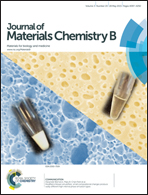Three-dimensional Fe- and N-incorporated carbon structures as peroxidase mimics for fluorescence detection of hydrogen peroxide and glucose†
Abstract
In this study, a simple and one-pot pyrolysis strategy is developed for the mass production of Fe, N-incorporated carbon nanotubes in situ grown on 3D porous carbon foam (denoted as Fe–Phen–CFs), which provides highly active Fe–N and doped-N species, and a large surface area with exposed active sites. The obtained composite exhibits intrinsic peroxidase-like catalytic activities. With the Fe–Phen–CFs as the catalyst, the peroxidase substrate of terephthalic acid (TA) can be oxidized to the fluorescent product of hydroxyterephthalate (HTA) by H2O2, which provides a unique strategy for fluorescence detection of H2O2. With such a process, as low as 68 nM H2O2 could be detected with a linear range from 0.1 to 100 μM. Meanwhile, by integrating glucose oxidase on the Fe–Phen–CFs composite, sensitive detection of glucose is also achieved with a linear range from 0.5 to 200 μM and a limit of detection of 0.19 μM. Most importantly, such a novel TA/Fe–Phen–CFs system can be successfully applied to glucose determination in real human serum samples. The unique nature and 3D structure of the Fe–Phen–CFs composite makes it promising for the fabrication of low-cost, high-performance biosensors.


 Please wait while we load your content...
Please wait while we load your content...